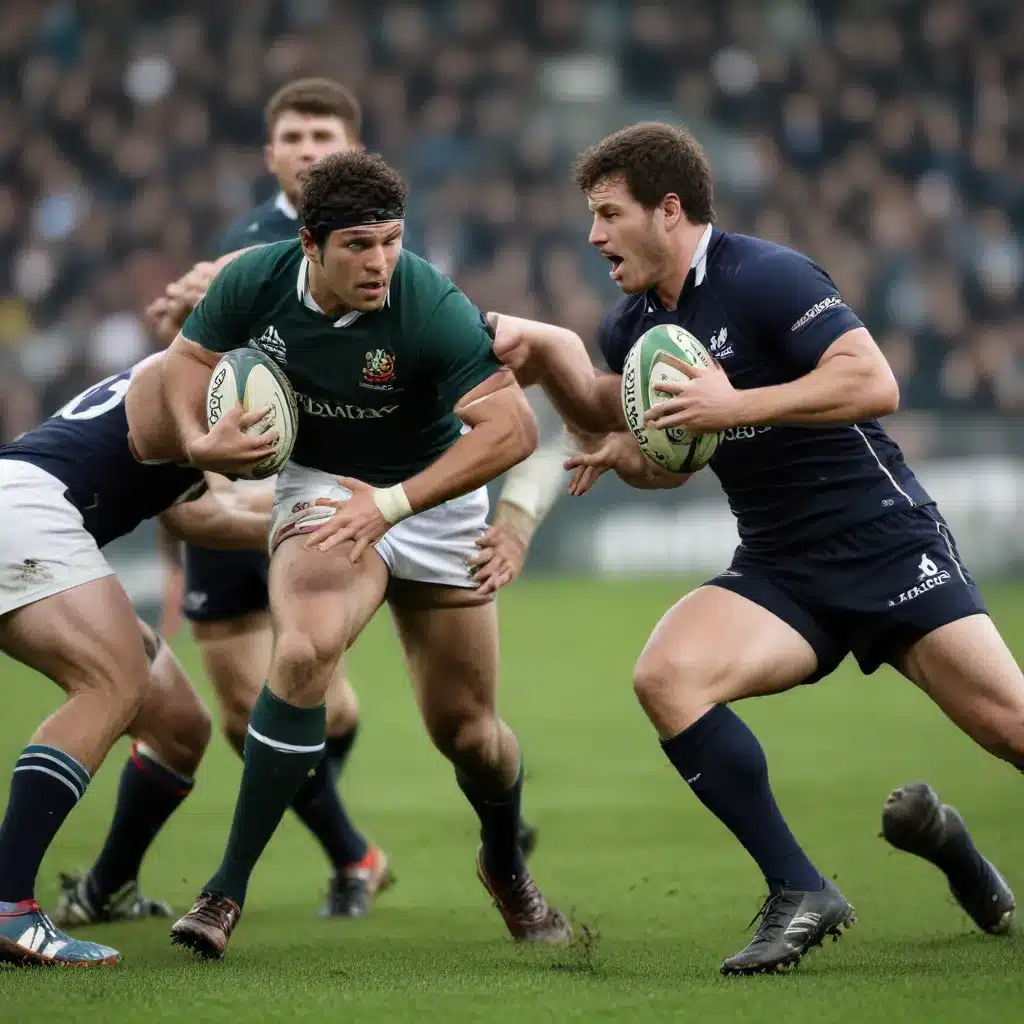
Rugby Fly Halves and Tactical Battle
Fly Half’s Role in Rugby
At the heart of any rugby team’s attack lies the fly half, the pivotal playmaker who orchestrates and dictates the flow of the game. This position is often referred to as the “tactical general” of the team, responsible for making split-second decisions that can make or break a match. As a seasoned rugby professional, I’ve witnessed firsthand the crucial role the fly half plays in controlling the ebb and flow of the tactical battle.
The fly half’s primary responsibilities include orchestrating the team’s attacking play, controlling the tempo of the game, and making vital decisions under immense pressure. They must possess an exceptional understanding of the game’s nuances, the ability to read the opposition’s defensive setup, and the skill to execute a wide range of passing, kicking, and running options.
Tactical Considerations for Fly Halves
Field Position Management
One of the fly half’s primary tactical considerations is the management of field position. Through their kicking game, they must constantly seek to gain territorial advantage, pushing the opposition back and creating opportunities to attack. This can be achieved through a variety of kicking strategies, including grubber kicks, chip kicks, and cross-field kicks, each designed to exploit specific defensive weaknesses.
Additionally, the fly half must be adept at engaging in territorial exchanges, carefully weighing the risks and rewards of kicking for territory versus running the ball. This delicate balance requires a deep understanding of the match situation, the team’s capabilities, and the opponent’s tendencies.
Possession Management
Closely linked to field position is the fly half’s management of possession. As the primary decision-maker, the fly half must ensure the team retains the ball, maintaining a high level of accuracy in their passing and decision-making. Turnovers can be devastating, and the fly half must be able to read the game, anticipate defensive pressure, and make the right choices to keep the team’s attacking momentum.
Game Management
Beyond just orchestrating the attack, the fly half is responsible for managing the overall ebb and flow of the game. This involves constantly reading the scenario, identifying opportunities, and adapting the team’s tactical approach accordingly. The ability to make quick, informed decisions and adjust the game plan on the fly is a hallmark of the true fly half maestro.
Controlling the Tactical Battle
Decision-Making Processes
At the heart of the fly half’s role is the ability to make critical decisions under intense pressure. This decision-making process involves rapidly assessing the current situation, identifying the best available options, and choosing the most appropriate course of action. The fly half must possess a keen analytical mind, the foresight to anticipate the opposition’s moves, and the confidence to execute their chosen plan.
Factors Influencing Decisions
The fly half’s decision-making is influenced by a multitude of factors, including the opponent’s defensive setup, the team’s attacking capabilities, and the overall match situation. They must constantly evaluate these variables and adjust their approach accordingly, seamlessly transitioning between different tactical approaches to gain the upper hand.
Fly Half’s Tactical Arsenal
To control the tactical battle, the fly half must have a well-developed arsenal of skills and techniques at their disposal. This includes a mastery of passing, from flat, direct passes to looped, deceptive deliveries, as well as a varied kicking game that encompasses grubber kicks, chip kicks, and cross-field bombs.
Passing Techniques
The fly half’s passing game is the foundation of their tactical repertoire. Accurate, timely passes are essential for maintaining possession and creating space for the team’s attacking threats. The ability to execute a range of passing options, from flat, direct passes to looped, deceptive deliveries, allows the fly half to keep the defense guessing and exploit any gaps that may appear.
Kicking Strategies
The fly half’s kicking game is a crucial element in their tactical arsenal. By employing a diverse range of kicking techniques, such as grubber kicks, chip kicks, and cross-field bombs, the fly half can effectively manipulate field position, force the opposition to turn and chase, and create scoring opportunities for their team.
Situational Awareness and Game Management
Reading the Tactical Landscape
The fly half’s ability to read the tactical landscape and anticipate the opposition’s moves is vital to their success. Through keen observation and deep rugby intelligence, they must identify defensive weaknesses, recognize patterns in the opposition’s play, and make informed decisions to exploit these vulnerabilities.
Adapting Tactics to the Scenario
As the game unfolds, the fly half must constantly adapt their tactics to the evolving scenario. This may involve slowing down the tempo of the game to regain control, or alternatively, maintaining a high-intensity, momentum-driven approach to capitalize on the opposition’s fatigue or indiscipline. The fly half’s ability to make these adjustments on the fly is a hallmark of their game management expertise.
Mastering the Fly Half’s Duel
Developing Tactical Expertise
Becoming a truly exceptional fly half requires a relentless dedication to honing one’s decision-making skills and tactical awareness. This involves extensive training, both on the pitch and in the video room, analyzing game footage, and studying the nuances of the position.
Collaborative Approach
While the fly half is often the focal point of the team’s attacking play, their success is heavily dependent on their ability to integrate seamlessly with the team’s overall strategies and communicate effectively with their teammates. By fostering a collaborative approach, the fly half can ensure that their decision-making and tactical execution are aligned with the collective goals of the squad.
At Aberdeenshire RFC, we understand the vital importance of the fly half’s role in controlling the tactical battle. Our coaching staff works tirelessly to develop the decision-making skills, situational awareness, and technical mastery of our fly halves, empowering them to orchestrate our team’s attack and navigate the ever-evolving challenges of the game. By mastering the fly half’s duel, our players can unlock the true potential of our team and lead us to success both on and off the pitch.
